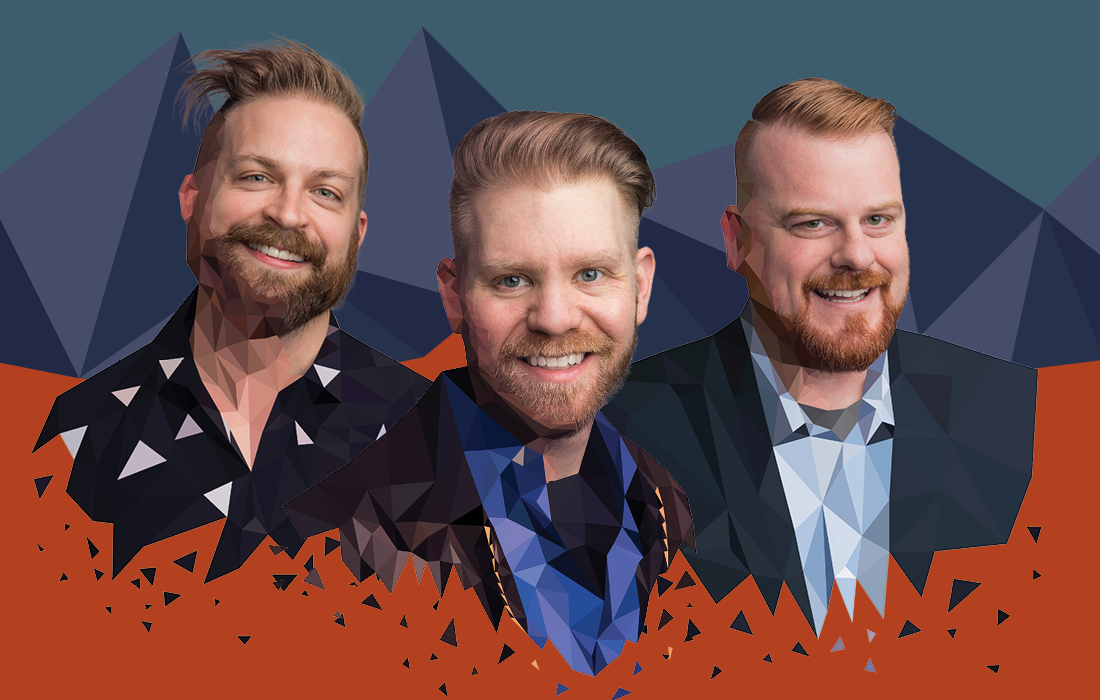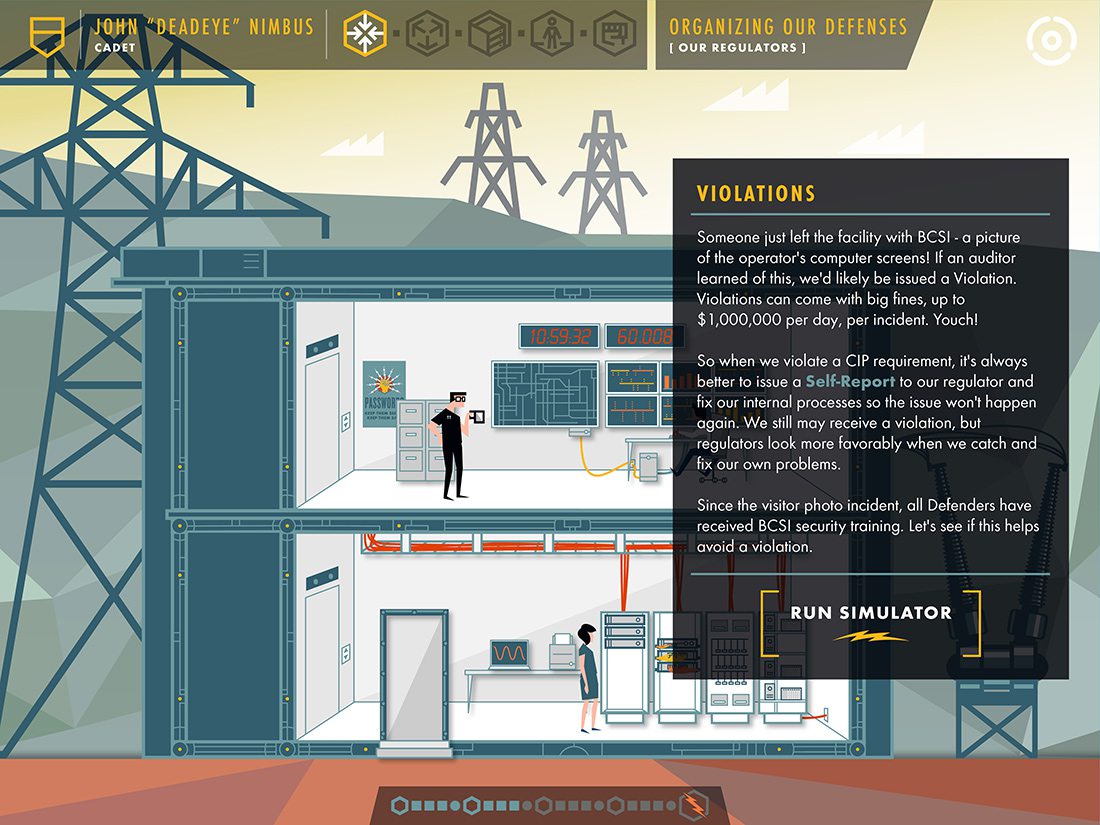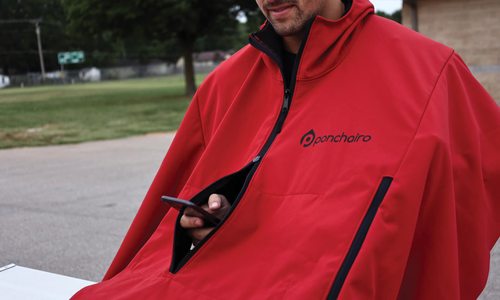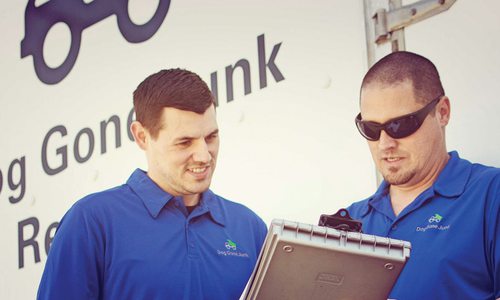
Startups
This 417-land Startup is Revolutionizing Employee Training
Three entrepreneurs have undertaken a mythical mission to save energy-industry security employees from the scourges of the three-ring binder and PowerPoint. And their company, MetaMythic, might just change the employee-training game for good.
By Matt Lemmon
Mar 2018

The attack is already underway, and you are the only one who knows that the entire region’s power grid has been compromised. The robot at the door is easily 8 feet tall, belonging to the dreaded MauraderBot family, and he’s angry. You have a choice to make: Do you deploy a standard but effective badge-reader? Perhaps you confuse it with an eye scanner? Or do you go with the big gun: a state-of-the-art body-scanning system? The choice is yours.
If the scenario sounds like something Jack Bauer might have to do on a particularly stressful day or like the video games you spent time mashing buttons to as a college student, the comparisons are apt, if far more frivolous than the reality. It is a video game, technically a training simulation. The players: actual energy-industry employees learning the latest cybersecurity techniques. The stakes: nothing less than the stability and safety of the utility systems that serve hundreds of millions of Americans every day, including many in 417-land. The program is called MetaMythic, and it was invented and developed right here in the Ozarks. And like most great quests, its story includes brave characters, struggles and obstacles that had to be overcome, and more than a little adventure along the way.
Like most innovations, MetaMythic’s roots are in a very specific and practical problem. In 2010, Christopher Lazzaro was charged with training a group of employees at Springfield-based Associated Electric Cooperative Inc., where he works as manager of energy systems, in critical infrastructure protection (CIP) standards. Here’s the thing about security standards in the post-9/11 utility industry: They are intense. Fines can reach $1 million per incident, per day. The issues are of an ever-changing technical nature and come with an acute degree of political attention. Lazzaro’s team, like many across the nation, needed help.
“They were struggling to understand the standards and apply them to daily work,” Lazzaro says. “You could sit through a week of vendor-provided training, reviewing the standards in their legal language, and never actually learn how to use them.” He developed a role-based handbook for frontline workers, but it fell short. “It was still really boring,” Lazzaro says. “No one went to college or trade school to learn compliance. It’s just naturally disengaging.”
Enter Michael Dockery, who at the time was an art director for deep, a part of the Marlin Network, and an acquaintance of Lazzaro’s from church. Lazzaro knew Dockery had developed a program that used a digital He-Man–like character to discuss elements of corporate culture. Dockery admits it wasn’t great at the time, but it was the seed of an idea, one Lazzaro thought he might be able to use to help the employees at Associated Electric. “Could we weave fiction and story into the boring content and actually make this kind of thing fun?” Lazzaro asked. “Could we smash fear with engagement?” MetaMythic had the beginnings of a cast. Now it needed its story.
“If this was something that was too silly and far-fetched, there was no way it would work. An audience can see the superficial; they can smell it.”— Michael Dockery, MetaMythic Chief Creative Officer
Lazzaro and Dockery got to work on a plot and characters. Zombies? Space marines? In the end, the only idea that really worked for cybersecurity was robots. “Pragmatically, they could attack different vectors where we are vulnerable,” Lazzaro says. And although the situations were decidedly fictional (an actual 8-foot robot is somewhat unlikely to attack the electrical grid, after all) the methods they employed—such as a malware-infested jump drive or the physical destruction of an electrical substation—were very real. Most importantly, the lessons themselves had to directly instruct the utility employees how to defend against the cyberattacks. It had to be lean and direct, with very little filler. “If this was something that was too silly and far-fetched, there was no way it would work,” Dockery says. “An audience can see the superficial; they can smell it.” Dockery went to work on some concepts that he hoped Associated Electric would like, fully expecting Lazzaro to play the proverbial “client card” and ask him to take a step or two back. Instead, he loved it and wanted him to take the concept further. “From that point forward it was game on,” Dockery says.
Fast forward a few months. A handbook was assembled, markedly different from the typical three-ring binder Associated Electric employees usually received at trainings. Odd posters, featuring parts of robots, foreshadowed an August training that no one quite understood beforehand. On the day of the training, Lazzaro says, employees still expected the leadership bait-and-switch. Instead, they were handed a handbook and asked to fight an evil robot threat. With each new chapter they were told of their very specific role to play against the hypothetical threat, and the missteps they might take that would lead to a costly violation. Every paragraph of the text was designed to have something humorous or at least lore-driven by the story. Socratic dialogue eased the highly technical content. People laughed, and at the end they literally clapped. “We were like, ‘What just happened?’” Lazzaro says. “And it was compliance training.”
With the first year of training an obvious success, the project was expanded for year two. Quickly, Lazzaro brought in Charlie Evans, an energy-industry veteran from Wisconsin who had joined Associated Electric to oversee energy-management infrastructure and software. Evans loved the concept Lazzaro and Dockery had piloted. Though sanctioned and funded by Associated Electric, the second iteration of training still required some resourcefulness to remain within budget while still meeting the trainees’ increased expectations. Lazzaro, Evans and Dockery decided to use a combination of video and live action role play, starring friend and local comedian Chad Harris as lead character “Brit Beacon,” who at one point burst into the room to interact with employees. The evil robot attackers theme was expanded to include the revelation that one of the attendees was a robot in disguise. At the end, everyone received dog tags. Trainees took their fictional identities with them; some of them keep their certificates and ID tags on their desks to this day. Most importantly, a group that had been struggling to grasp security standards has since gone more than six years without a violation.

“You can throw a three-ring binder at them, but if you give them an experience that treats them as a hero, that’s important.”— Christopher Lazzaro, MetaMythic CEO
“It was a really cathartic experience for everyone,” Lazzaro says. “Everyone was talking about compliance and looking for compliance issues, all because we told the team that they were important to the mission of sustaining compliance, and then we made them feel that way. You can throw a three-ring binder at them, but if you give them an experience that treats them as a hero, that’s important.”
But an in-house training product does not a startup make, and the training concept the trio had built remained limited to Associated Electric for the next couple of years. At that time Dockery, now at Marlin’s The Alchemedia Project, was charged with developing a program to teach Marlin employees about the company’s brand-new Employee Stock Ownership Plan (ESOP). A change in corporate and compensation structure is never easy to grasp, or popular, but when explained only by a 35-page document written by a lawyer, Dockery says it’s an even tougher transition for the right-brained types in Marlin’s advertising ranks. Dockery, with Lazzaro and Evans, was asked to help.
This concept called for a new story (robots weren’t going to cut it), which evolved into a Lovecraft-meets–Harry Potter-meets–Army of Darkness concept that would hopefully meet the expectations of Marlin’s creative class. But the results were similar—post-training surveys showed that employees not only understood the ESOP but were willing and able to share and explain it to family and friends. Perhaps most importantly, it proved that the applied-fiction concept could work for companies outside of the energy industry.
At this point, Lazzaro, Evans and Dockery were still working 40-plus hours a week at their day jobs (and continue doing so to this day), all while balancing family life and growing and developing MetaMythic in their free time. But they knew they had something. Each founder had specific skills that allowed the product to run efficiently, but enough knowledge of the other founders’ domains to create a solid working nucleus. “While the concept was absolutely solid, we didn’t understand the unique team that we had to pull it off,” Evans says. “How often do you mesh people with experience in software design, digital art, animation, cybersecurity knowledge, culture-change leadership, project management and more together in one group?”
The trio set to work modifying the methodology of their applied fiction to solve training problems in any industry “where there’s a natural disengagement, or mission needs an acceleration,” as Lazzaro puts it. First step: a name. The trio chose MetaMythic in 2014. Second step: a way to get in front of people. Based on their success at Associated Electric, MetaMythic was invited to speak at UX Week, a tech-design conference in San Francisco, and then at the National Electric Reliability Corporation’s (NERC) Human Performance Conference, which Evans describes as the cutting-edge conference for the energy industry and one of the company’s watershed moments. At NERC the crowd was so enthused they delayed the following speaker to hear more about the MetaMythic concept. (The company has been invited to speak at NERC conferences each year since.) “We had just hit the startup owners manual first criteria: ‘Do people get excited when you give your pitch?’” Lazzaro says. “They’d never seen anything like it, and the energy and excitement was incredible.”
Based on their success on the speaking circuit the interest was there. But the hurdles of the existing model soon became apparent. The only model they had used so far was a custom handbook used in a live-training context, and that’s what they were pitching. The time and effort involved in developing quality, custom programming for far-flung clients in industries none of the founders had experience in, no less, proved daunting. “It scared us,” Dockery says. “We have families that we like! And we didn’t want to be traveling all the time, but we had to take this a few steps further.”
MetaMythic by the Numbers
Employees trained
by MetaMythic applied-fiction products since 2010 (Note: 5,000 is an approximate number)
International awards
won by MetaMythic team
Months
a typical product takes in development
Standard cybersecurity
training engagement rate
CIP Defender
training engagement rate
National conference
keynote presentations
Office locations,
including founders’ homes and nearly every coffee shop in Springfield
Unsolicited positive quotes
sent by users to their training managers after taking training
Children born
to founders since MetaMythic was created
Cost also proved to be a hurdle. The price tag for customized trainings approached six digits, which turned off the initially exuberant prospects. The process simply had too many variables, and MetaMythic lacked a portfolio of satisfied paying customers (Associated Electric had absorbed the security standards training costs, and the Marlin job was pro bono). The founders had an exciting concept but no product to sell, and without a huge influx of capital, it seemed there was no way out.
But early in 2015, a way presented itself. With more than 1.2 million customers, Arizona Public Services (APS) is the largest utility operation in its state and one of the largest in the country. The company needed MetaMythic to train employees at 30 locations around the state. But they needed it packaged differently—it needed to be online and accessible to different employees at different times. It quickly became apparent to Lazzaro, Evans and Dockery that they needed an e-learning product that they could tweak for different clients.
The job was the break MetaMythic was looking for: APS would fund the development while Lazzaro, Dockery and Evans would retain the intellectual property. But months of negotiations left them with just the final four months of 2015 to develop what was, for all intents and purposes, a short film, a video game and an educational website all rolled into one. Three months before the deadline, it became clear that their original third-party developer was going to be unable to come through, so a mad scramble to hire a national partner ensued. Then, at a fall conference it became apparent that competitors were entering the virtual training space. On the eve of publication, a problematic bug in how the program ran on Internet Explorer took three weeks to find, with a patch discovered literally 11 minutes before a hard delivery deadline.
But delivered it was. The finished product, named CIP Defender, is a browser-based program—an educational video game, for lack of a better term—in which users must defend their utility property against various evil robot attackers by employing the systems they use every day. MetaMythic has since developed a second season of the training and added customer-requested bells and whistles. It’s immersive, it’s funny, and it’s great-looking. Most importantly, it works. CIP Defender and MetaMythic have been showered with accolades from the industry and show sterling engagement rates from MetaMythic’s very pointed follow-up surveys, with rates consistently topping 85 percent. MetaMythic recently has been part of an official engagement study in conjunction with Kent State University and the University of Central Missouri.
Since early 2016, MetaMythic’s growth has been slow and steady, with custom applied-fiction products developed for nine clients working primarily in the utility-security industry. Lazzaro says the deliberate pace of growth for MetaMythic is partially strategic and partially due to the intrinsically conservative nature of the utility industry, with its penchant for slow decision-making and long time horizons. The antidote to this, Evans says, is customer relations. “The [utility] industry is highly relational,” he says. “Our company was birthed in this industry, we know the challenges, the people, and the needs,” he says. “Therefore, we can relate very well to our customers. In addition, getting some large customers out of the gate allowed us to assuage some concerns through stellar references with peers that they are comfortable with.”
With those positive relations under its belt, MetaMythic is exploring partnerships to expand distribution in America and to the Middle East and discussing new products in non-energy industries, including railroad, finance and health care. Although competitors are developing—one pursuer in particular will mimic MetaMythic innovations almost like clockwork—the strategy remains not to look back at the competition for ideas, but keep innovating out front. “We want to keep pushing the boundary of what’s possible and stay far ahead of the competition by being the thought-leaders in this space,” Lazzaro says. “The good news is that Applied Fiction is our unique innovation, and it’s not easy to duplicate, so it’s not been difficult to stay ahead of the copycat.”
And although the business goal is to become recognized as the “Disney of the industry,” Lazzaro, Evans and Dockery are all very cognizant that the non-fictional good MetaMythic does every day is very tangible—and very important. “We’re helping people learn stuff they should know and [making] them more effective at their jobs,” Dockery says. “And most of these jobs and companies are very beneficial for the average person who has no idea it’s going on.”
What They’ve Learned
The MetaMythic team shares takeaways of their entrepreneurial partnership and remaining sane (and married) while juggling 40-plus-hour day jobs and a demanding startup.
On what they would do differently:
“We converted to a Dynamic Equity company ownership model to ensure that harmony was maintained among the founders. There were many difficult conversations during this transition, but it truly is a more fair model for a startup. It would have been much easier to start on this model.”—Charlie Evans
“I would have gotten closer to the Springfield business community earlier. Today we have a good relationship with The eFactory and other community leaders, but we didn’t pursue these until mid-2017. I think it was a combination of being elevated to the national level so early and my own personal assumption that only bigger cities have good startup resources. I’m glad I was shown to be wrong.”—Christopher Lazzaro
On finding work-life balance:
“No matter how exhausted I am, I still carve out time for my wife and kids. They are more important to me than any of this and keep me tethered to humanity.”—Michael Dockery
“There is always more to do. Sometimes though, the batteries just need to be recharged and your perspective needs a break. Taking an occasional weekend off can miraculously help you accomplish more than working through it.”—C.E.
“We’ve learned to never make important decisions when we’re at low energy levels—that each of us has a responsibility to raise the net energy level of the team in every meeting and interaction. If someone is really low, we pool our collective energy and give that person help, and when we’re all low on energy, we all take a break as soon as possible.”—C.L.
“We each established monthly strategic meetings with our families. Once you establish this honest dialog with your family [and] get commitment on the current business path, it makes it easier for everyone to accept the challenges and long hours required to pull it off.”—C.E.
“Pick your founders carefully. They may not be your life partners, but they are your partners-in-life. You need to have the utmost trust, respect, vulnerability and safety around them.”—C.L.
On their competition:
“Our biggest competition is the PowerPoint deck. It’s never effective, but moving from the $0 hard cost (with high hidden costs) PowerPoint training to our training can be a big conceptual jump for people. They have to understand and believe in the engagement and retention numbers.”—C.L.
On perseverance:
“God will provide. There have been more than a few instances where we three have looked at each other and said, ‘Well, crap, we may be really screwed this time,’ only for our collective bacon to be saved at just the most miraculous moment.”—M.D.
“We were literally about to shut the doors to MetaMythic, and something or somebody beyond our control or expectations interfered and breathed hope into a hopeless situation. I think these near-death experiences for MetaMythic keep us all both humble and grateful for the time and the journey we’ve been given to positively impact people and organizations.”—C.L.
MetaMythic Accolades
2014 PRINT
Regional design Annual Award
Brandon Hall Gold in 2016
for Best Advance in Compliance Training
Brandon Hall Silver in 2016
for Best Advance in Custom Content
Brandon Hall Gold in 2017
for Best Advance in Compliance Training (for season 2 of the CIP Defender storyline)
Learning Technologies Award
for Best Use of Technology for Compliance Training
Are you ready to become a hero?
Think you have what it takes to succeed at CIP Defender and protect our country’s vital electrical and utility infrastructure? Try MetaMythic’s special demo for Biz 417 readers and find out.












